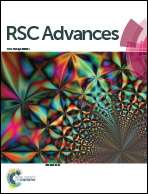Computational simulation of anion binding association mechanisms contributing toward rotation of pyrrole rings in dipyrrolyldiketone BF2 complexes†
Abstract
Dipyrrolyldiketone BF2 complexes have a characteristic association mechanism with anions; an anion is tightly captured by the NH bonding of the two rotated pyrrole rings and the CH bonding of the backbone in dipyrrolyldiketone BF2 complexes. In order to elucidate this anion association mechanism in dipyrrolyldiketone BF2 complexes, the relative stability of several conformers of the dipyrrolyldiketone BF2 complex and anion complexes are initially calculated by quantum mechanical density functional theory (DFT). Second, molecular dynamics (MD) simulations were performed for systems comprising a dipyrrolyldiketone BF2 complex and Cl− with several types of countercations in CH2Cl2. From our DFT calculations, it was observed that isomerization could be classified by whether Cl− changes its position relative to the dipyrrolyldiketone BF2 complex or not. From the MD simulations, we found the size effect of countercations: a large cation is released from dipyrrolyldiketone BF2 complexes more frequently than smaller cations. Meanwhile, when Na+ is employed as the cation, the formation of a seven-membered ring-like cluster suppresses both the isomerizations. Furthermore, MD simulations suggest that the presence of an anion is critical to stabilize the two rotated pyrrole rings. Hence, from our MD simulations, we have clearly found that the size of the cation affects the isomerization processes.



 Please wait while we load your content...
Please wait while we load your content...